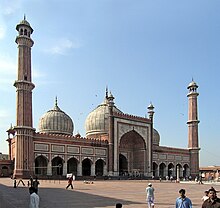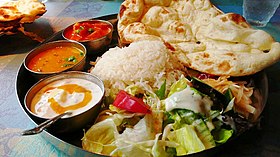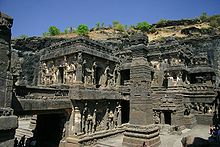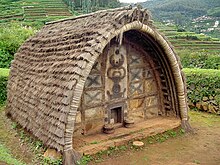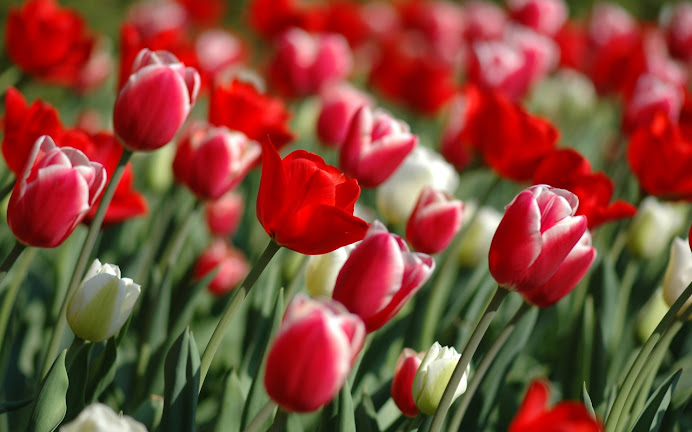Traditional Indian clothes for women are the salwar kameez or the sari. For men on the other hand it is the Dhoti, Lungi or Kurta.
Salwars are pleated at the waist and held up by a drawstring or an elastic belt. The pants can be wide and baggy, or they can be quite narrow and made of fabric cut on the bias. In the latter case, they are known as churidars. The kameez is usually cut straight and flat; older kameez use traditional cuts, as shown in the illustration; modern kameez are more likely to have European-inspired set-in sleeves. The tailor's taste and skill are usually displayed not in the overall cut, but in the shape of the neckline and the decoration of the kameez.
When women wear the salwar kameez, they usually wear a long scarf or shawl called a dupatta around the head or neck. For Muslim women, the dupatta is a less stringent alternative to the chador or burqa (see hijab and purdah). For Hindu women (especially those from northern India, where the salwar kameez is most popular), the dupatta is useful when the head must be covered, as in a temple or the presence of elders. For other women, the dupatta is simply a stylish accessory that can be worn over one shoulder or draped around the chest and over both shoulders.
Modern versions of the feminine salwar kameez can be much less modest than traditional versions. The kameez may be cut with a plunging neckline, sewn in diaphanous fabrics, or styled in sleeveless or cap-sleeve designs. The kameez side seams may be split high up to the waistline and, it may be worn with the salwar slung low on the hips. When women wear semi-transparent kameez (mostly as a party dress), they wear a choli or a cropped camisole underneath it.
The Shalwar kameez is sometimes known as "Punjabi suit," in Britain[1] and Canada.[2] In Britain, especially during the last two decades, the garment has been transformed from an everyday garment worn by immigrant South Asian women from the Punjab region to one with mainstream, and even high-fashion, appeal.[3]
[edit] Etymology and history
 Portrait of a Hindu girl from Karachi, Sind, in narrow salwar & kameez. c. 1870. Oriental and India Office Collection, British Library. |  Portrait of a Muslim girl from Karachi, Sind, in a salwar and blouse. c. 1870. Oriental and India Office Collection, British Library. |  Hill women, Kashmir, in salwar-kameez. c. 1890. British Library. |
The pants, or salwar, are known as shalwar in Punjabi: ਸਲਵਾਰ ਕਮੀਜ਼, salwaar or shalwaar શલવાર કમીઝ in Gujarati, salwaar or shalwar शलवार कमीज़ in Hindi, and shalwar in Urdu: شلوار قمیض. The word comes from the Persian: شلوار, meaning pants, ultimately from Arabic sarwal : سروال , note the inversion of the letters ل and ر which has happened in the adaptation process.
There are two main hypotheses regarding the origin of the Arabic word, namely:
- that Arabic qamis is derived from the Latin camisia (shirt), which in its turn comes from the Proto-Indo-European kem (‘cloak’). [4]
- that Mediaeval Latin camisia is a borrowing through Hellenistic Greek kamision from the Central Semitic root “qmṣ”, represented by Ugaritic qmṣ (‘garment’) and Arabic qamīṣ (‘shirt’). Both of these are related to the Hebrew verb קמץ qmṣ (‘grip’, ‘enclose with one’s hand’). [5]
Garments cut like the traditional kameez are known in many cultures; according to Dorothy Burnham, of the Royal Ontario Museum, the "seamless shirt," woven in one piece on warp-weighted looms, was superseded in early Roman times by cloth woven on vertical looms and carefully pieced so as not to waste any cloth. 10th century cotton shirts recovered from the Egyptian desert are cut much like the traditional kameez or the contemporary Egyptian jellabah or galabia.[6]
Wide legged pants with drawstring were worn in many areas ruled by Turko-Iranian horse riding steppe peoples of Central Asia. The Ottoman empire was ruled by Turks; many Iranian dynasties, including the recent Qajar dynasty, were of Turkic origin. Their characteristic clothing became court dress and eventually popular dress. Their wide-legged pants have been called Turko-Mongol[7] and Turco-Persian.[8] This style is still worn in contemporary Turkey and Iran.
Sari
A sari or saree or shari is the traditional female garment in India, Pakistan, Bangladesh, Nepal, and Sri Lanka.[1] A sari is a strip of unstitched cloth, ranging from four to nine metres in length that is draped over the body in various styles. The most common style is for the sari to be wrapped around the waist, with one end then draped over the shoulder baring the midriff.[1] The sari is usually worn over a petticoat (pavada/pavadai in the south, and shaya in eastern India), with a blouse known as a choli or ravika forming the upper garment. The choli has short sleeves and a low neck and is usually cropped, and as such is particularly well-suited for wear in the sultry South Asian summers. Cholis may be "backless" or of a halter neck style. These are usually more dressy with a lot of embellishments such as mirrors or embroidery and may be worn on special occasions.Women in the armed forces, when wearing a sari uniform, don a half-sleeve shirt tucked in at the waist.
Styles of draping

This painting by
Raja Ravi Varma depicts many (but not all) traditional styles of draping the sari
The most common style is for the sari to be wrapped around the waist, with the loose end of the drape worn over the shoulder, baring the stomach. [1] However, the sari can be draped in several different styles, though some styles do require a sari of a particular length or form. The French cultural anthropologist and sari researcher, Chantal Boulanger, categorizes sari drapes in the following families:[2]
- Nivi – styles originally worn in Tamil Nadu; besides the modern nivi, there is also the kaccha nivi, where the pleats are passed through the legs and tucked into the waist at the back. This allows free movement while covering the legs.
- North Indian/Gujarati – this style differs from the nivi only in the manner that the loose end is handled: in this style, the loose end is draped over the right shoulder rather than the left, and is also draped back-to-front rather than the other way around.
- Maharashtrian/Kache – This drape (front and back) is very similar to that of the male Maharashtrian dhoti. The center of the sari (held lengthwise) is placed at the center back, the ends are brought forward and tied securely, then the two ends are wrapped around the legs. When worn as a sari, an extra-long cloth is used and the ends are then passed up over the shoulders and the upper body. They are primarily worn by Brahmin women of Maharashtra, Karnataka, Andhra Pradesh and Tamil Nadu.
- Dravidian – sari drapes worn in Tamil Nadu; many feature a pinkosu, or pleated rosette, at the waist.
- Madisaara style – This drape is typical of Brahmin ladies from Tamil Nadu and Kerala
- Kodagu style – This drape is confined to ladies hailing from the Kodagu district of Karnataka. In this style, the pleats are created in the rear, instead of the front. The loose end of the sari is draped back-to-front over the right shoulder, and is pinned to the rest of the sari.
- Gond – sari styles found in many parts of Central India. The cloth is first draped over the left shoulder, then arranged to cover the body.
- the two-piece sari, or mundum neryathum, worn in Kerala. Usually made of unbleached cotton and decorated with gold or colored stripes and/or borders.
- tribal styles – often secured by tying them firmly across the chest, covering the breasts.
The nivi style is today's most popular sari style. (Dongerkerry K. S. 1959).[3]
- The nivi drape starts with one end of the sari tucked into the waistband of the petticoat. The cloth is wrapped around the lower body once, then hand-gathered into even pleats just below the navel. The pleats are also tucked into the waistband of the petticoat.[3] They create a graceful, decorative effect which poets have likened to the petals of a flower.[3]
- After one more turn around the waist, the loose end is draped over the shoulder.[3] The loose end is called the pallu or pallav. It is draped diagonally in front of the torso. It is worn across the right hip to over the left shoulder, partly baring the midriff.[3] The navel can be revealed or concealed by the wearer by adjusting the pallu, depending on the social setting in which the sari is being worn. The long end of the pallu hanging from the back of the shoulder is often intricately decorated. Some nivi styles are worn with the pallu draped from the back towards the front.
The Nivi saree was popularised through the paintings of Raja Ravi Verma.[4] by modifying the south indian saree called mundum neriyathum. In one of his painting the Indian subcontinent was shown as a mother wearing a flowing nivi saree.[4]
In Pakistan
In Pakistan, the wearing of saris has almost completely been replaced by the shalwar kameez for everyday wear, though it remains a popular dress for formal functions, especially weddings amongst the Pakistani elite, and is currently gaining interest.[5] The sari is sometimes worn as daily-wear, mostly in Karachi, by those elderly women who were used to wearing it in pre-partition India[6] and by the some of the new generation who have re-introduced the interest of saris.[7][8] The reason why the sari lost popularity in Pakistan, was due to it being viewed as a Hindu dress. Although she was seen wearing them,[6] Fatima Jinnah, the "Mother of the Nation", called the sari "unpatriotic" and Pervez Musharraf's wife stated that she never wears them.[9]
In Sri Lanka
Sri Lankan women wear saris in many styles. However, two ways of draping the sari are popular and tend to dominate; the Indian style (classic nivi drape) and the Kandyan style (or 'osaria' in Sinhalese). The Kandyan style is generally more popular in the hill country region of Kandy from which the style gets its name. Though local preferences play a role, most women decide on style depending on personal preference or what is perceived to be most flattering for their figure.
The traditional Kandyan (Osaria) style consists of a full blouse which covers the midriff completely, and is partially tucked in at the front as is seen in this 19th century portrait. However, modern intermingling of styles has led to most wearers baring the midriff. The final tail of the sari is neatly pleated rather than free-flowing. This is rather similar to the pleated rosette used in the 'Dravidian' style noted earlier in the article.
The sari as cloth
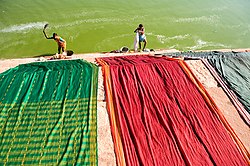
Saris being laundered and left to dry

Group of sari-clad women wearing everyday saris in
Ujjain Saris are woven with one plain end (the end that is concealed inside the wrap), two long decorative borders running the length of the sari, and a one to three foot section at the other end which continues and elaborates the length-wise decoration. This end is called the pallu; it is the part thrown over the shoulder in the Nivi style of draping.
In past times, saris were woven of silk or cotton. The rich could afford finely-woven, diaphanous silk saris that, according to folklore, could be passed through a finger-ring. The poor wore coarsely woven cotton saris. All saris were handwoven and represented a considerable investment of time or money.
Simple hand-woven villagers' saris are often decorated with checks or stripes woven into the cloth. Inexpensive saris were also decorated with block printing using carved wooden blocks and vegetable dyes, or tie-dyeing, known in India as bhandani work.
More expensive saris had elaborate geometric, floral, or figurative ornament created on the loom, as part of the fabric. Sometimes warp and weft threads were tie-dyed and then woven, creating ikat patterns. Sometimes threads of different colors were woven into the base fabric in patterns; an ornamented border, an elaborate pallu, and often, small repeated accents in the cloth itself. These accents are called buttis or bhutties (spellings vary). For fancy saris, these patterns could be woven with gold or silver thread, which is called zari work.
Sometimes the saris were further decorated, after weaving, with various sorts of embroidery. Resham work is embroidery done with colored silk thread. Zardozi embroidery uses gold and silver thread and sometimes pearls and precious stones. Cheap modern versions of zardozi use synthetic metallic thread and imitation stones, such as fake pearls and Swarovski crystals.
In modern times, saris are increasingly woven on mechanical looms and made of artificial fibers, such as polyester, nylon, or rayon, which do not require starching or ironing. They are printed by machine, or woven in simple patterns made with floats across the back of the sari. This can create an elaborate appearance on the front, while looking ugly on the back. The punchra work is imitated with inexpensive machine-made tassel trim.
Hand-woven, hand-decorated saris are naturally much more expensive than the machine imitations. While the over-all market for handweaving has plummeted (leading to much distress among Indian handweavers), hand-woven saris are still popular for weddings and other grand social occasions.
Types of saris

The sari has been internationalised by flight attendants' uniform like this one modelled by an Indian Airlines mannequin
While an international image of the 'modern style' sari may have been popularised by airline stewardesses, each region in the Indian subcontinent has developed, over the centuries, its own unique sari style. Following are the well known varieties, distinct on the basis of fabric, weaving style, or motif, in South Asia:
Northern styles
Eastern styles

Banarosi Saree from Baily Road, Bangladesh
Western styles
Central styles
Southern styles
Origins and history

Illustration of a sari-clad,
barefoot woman, c. 1847
The word 'sari' evolved from the Prakrit 'sattika' as mentioned in earliest buddhist jain literature.[10]
The history of Indian clothing trace the sari back to the Indus valley civilization, which flourished in 2800-1800 BCE.[1] The earliest known depiction of the saree in the Indiain subcontinent is the statue of an Indus valley priest wearing a drape.[1]
Ancient Tamil poetry, such as the Silappadhikaram and the Kadambari by Banabhatta, describes women in exquisite drapery or saree.[11] In ancient Indian tradition and the Natya Shastra (an ancient Indian treatise describing ancient dance and costumes), the navel of the Supreme Being is considered to be the source of life and creativity, hence the midriff is to be left bare by the saree.[12]
Some costume historians believe that the men's dhoti, which is the oldest Indian draped garment, is the forerunner of the sari. They say that until the 14th century, the dhoti was worn by both men and women.[13]
Sculptures from the Gandhara, Mathura and Gupta schools (1st-6th century CE) show goddesses and dancers wearing what appears to be a dhoti wrap, in the "fishtail" version which covers the legs loosely and then flows into a long, decorative drape in front of the legs [1]. No bodices are shown.[14]
Other sources say that everyday costume consisted of a dhoti or lungi (sarong), combined with a breast band and a veil or wrap that could be used to cover the upper body or head. The two-piece Kerala mundum neryathum (mundu, a dhoti or sarong, neryath, a shawl, in Malayalam) is a survival of ancient Indian clothing styles, the one-piece sari is a modern innovation, created by combining the two pieces of the mundum neryathum.[15]
It is generally accepted that wrapped sari-like garments, shawls, and veils have been worn by Indian women for a long time, and that they have been worn in their current form for hundreds of years.
One point of particular controversy is the history of the choli, or sari blouse, and the petticoat. Some researchers state that these were unknown before the British arrived in India, and that they were introduced to satisfy Victorian ideas of modesty. Previously, women only wore one draped cloth and casually exposed the upper body and breasts. Other historians point to much textual and artistic evidence for various forms of breastband and upper-body shawl.
In South India, it is indeed documented that women from many communities wore only the sari and exposed the upper part of the body till the 20th century.[13] Poetic references from works like Shilappadikaram indicate that during the sangam period in ancient South India, a single piece of clothing served as both lower garment and head covering, leaving the bosom and midriff completely uncovered.[11] In Kerala there are many references to women being bare-breasted.[13] including many pictures by Raja Ravi Varma. Even today, women in some rural areas do not wear cholis.
Dhoti

Similar to
sarongs, dhotis are commonly worn with western-style oxford shirts by the men of South India.
The dhoti, called Laacha in Punjabi, mundu in Malayalam, dhuti in Bangla, veshti in Tamil, pancha in Telugu, dhotar in Marathi and panche in Kannada, dhoti in Pakistan is the traditional garment of men's wear in South Asia, especially India. It is a rectangular piece of unstitched cloth, usually around 5 yards long, wrapped about the waist and the legs, and knotted at the waist.
In northern India, the garment is worn with a Kurta on top, the combination known simply as "dhoti kurta", or a "dhuti panjabi" in the East. In southern India, it is worn with an angavastram (another unstitched cloth draped over the shoulders) or else with a "chokka"(shirt) or "jubba"(a local version of kurta). The lungi is a similar piece of cloth worn in similar manner, though only on informal occasions. The sarong is another similar item of clothing.
Design & Usage
The standard adult lungi is 115cm in height and 200cm in length, when open. It is normally woven from cotton in a variety of designs and colors. The most common styles are either solid-colored or plaid, partly since these patterns are cheaper to produce with a loom. Blue is a particularly popular, since it fades to pleasant tones in contrast to other colors. Regardless of the design or color, lungis are often lined at the top and bottom with a black/white stripe containing a heat-sealing resin to prevent fraying. Unlike dhotis, which are linear like sheets, lungis are sewn into a tube shape like a skirt. Depending on local tradition, lungis can be worn by men and/or women, are tied or fastened in various ways, and can be used in different cultural activities, ranging from normal daily life to elaborate wedding ceremonies. For daily purposes, a simple double knot is most popular, since it is least likely to slip or come undone. The lungi is thought to be quite comfortable, as its length can be adjusted rather easily. It is particularly popular in regions where the heat and humidity create an unpleasant climate for trousers.
Regional variations
Bangladesh and West Bengal
The lungi is the most commonly-seen dress of Bangladeshi men, although it is not normally worn on formal occasions. In Bangladesh, lungis are worn by most men on a daily basis, although elaborately-designed cotton, batik, or silk lungis are also often presented as wedding gifts to the groom. In Bangladesh, the lungi industry is concentrated in Khulna, and leading brands include ATM, Smart, and Alphabet Textiles. Bengali women do not traditionally wear lungis, although non-Bengali tribal women do wear similar garments in some parts of southeastern Bangladesh. In neighboring West Bengal, the lungi is fast replacing the dhoti as the most popular men's garment for everyday wear. Some Bengali men avoid wearing the lungi, considering it to be too informal or inappropriate, despite the fact that it is both ubiquitous and comfortable. Despite the fact that the usage of lungi is declining slowly, it is still the most common male attire in rural Bangladesh.
South India
In Kerala the lungi, locally known as Kaili or Kalli Mundu, is worn by both men and women. It is considered a casual dress or working dress of physical labourers. Lungis are generally colourful, and with varying designs. The plain white version of a lungi is known as a mundu. For more ceremonial occasions (like weddings), mundus often bear a golden embroidery known as kasavu. Lungis are not used during occasions such as weddings or other religious ceremonies. Saffron-coloured mundus are also known as kaavi mundu.
Coloured lungi is called Munda in central Karnataka. Plain white double folded cloth similar to lungi is called a panche. Panche as opposed to lungi is worn during formal ceremonies. These are also used in the state of Andhra Pradesh.
Lungis also comes in two types: Open Lungi, which is basically a piece of cloth wrapped around, and Closed Lungi, which is stitched to form a sort of a 'tube'. In Kerala open lungi is more popular.
Kerala men folk generally tuck up their mundus or lungis. The bottom of the garment is pulled up and tied back on to the waist. This would make the mundu or lungi only cover the body from the waist to the knees. In this fashion it somewhat resembles a kilt, but without pleats.
In Tamil Nadu, only the men wear this garment, and the usage is similar to Kerala's. It is also known as Kaili or Saaram/Chaaram in South Tamilnadu.
Materials
Kurtas worn in the summer months are usually made of thin silk or cotton fabrics; winter season kurtas are made of thicker fabric such as wool (as in Kashmiri kurtas) or Khadi silk, a thick, coarse, handspun and handwoven silk that may be mixed with other fibers.
Kurtas are typically fastened with tasseled ties, cloth balls and loops, or buttons. Ready-made kurtas often avoid the use of horn buttons, in deference to Hindu sentiments; such buttons are frequently made from cow or buffalo hooves or horns. Buttons are often wood or plastic. Kurtas worn on formal occasions might feature decorative metal buttons, which are not sewn to the fabric, but, like cufflinks, are fastened into the cloth when needed. Such buttons can be decorated with jewels, enameling, and other traditional jewelers' techniques.
Decoration
South Asian tailors command a vast repertoire of methods, traditional and modern, for decorating fabric. It is likely that all of them have been used, at one time or another, to decorate kurtas. However, the most common decoration is embroidery. Many light summer kurtas feature Chikan embroidery around the hems and front opening. This embroidery is typically executed on light, semi-transparent fabric in a matching thread. The effect is ornate but subtle.
History
Muslim scholar in kurta, East Bengal (Bangladesh), 1860 | Muslim Pahari (Hill) women in kurtas, Kashmir, 1890. | Hindu Dom man in short kurta, East Bengal (Bangladesh), 1860. |

